
The right heart has jokingly been referred to as the organ's stepchild, with little attention paid to its size, function, and prognostic implications. To help with this often overlooked task, our new article series will review the proper methods to quantify the right heart for both size and function.
In part 1, we'll review the general recommendations from the American Society of Echocardiography (ASE) for the right heart, share how to perform a comprehensive 2D assessment of the right heart, and identify the correct imaging windows for visualizing the right ventricle (RV). We'll also offer tips on how to better visualize the RV.
 Andrea Fields, clinical cardiac director at CardioServ. All images courtesy of CardioServ.
Andrea Fields, clinical cardiac director at CardioServ. All images courtesy of CardioServ.ASE recommendations
Over the years, the ASE has published papers on the right heart that often had conflicting information and reference ranges. In 2015, however, the society released its updated chamber quantification guidelines, which included a detailed description of the right heart to replace the previous conflicting information.
In the updated guidelines, the ASE recommends the following:
- All studies should include a comprehensive examination of the RV and right atrium (RA).
- The echo report should include both qualitative and quantitative parameters for right heart assessment:
- RV and RA size
- RV systolic function (via one or a combination of the following):
- Fractional area change (FAC)
- Tricuspid annular plane systolic excursion (TAPSE)
- S' wave
- Right ventricular index of myocardial performance (RIMP)
- RV systolic pressure:
- Tricuspid regurgitation (TR) jet
- Estimated right atrial pressure (RAP) based on inferior vena cava (IVC) size and collapsibility
In addition, the abnormal cutoff values were changed for RV dimensions, S' wave, TAPSE, and RIMP.
Comprehensive assessment of RV
The RV has three wall segments: the anterior wall, the inferior wall, and the lateral wall. To properly evaluate all segments of the RV, you will need to obtain five imaging views:
- Parasternal long-axis (PLAX) view
- Parasternal short-axis (PSAX) view
- RV inflow tract (RVIT) view
- Apical four-chamber view
- Subcostal four-chamber view
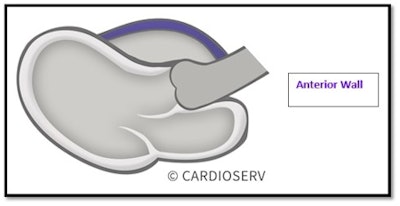
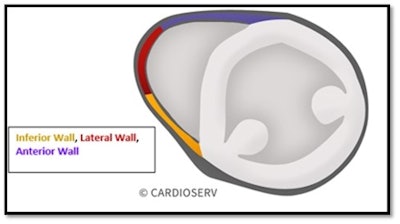

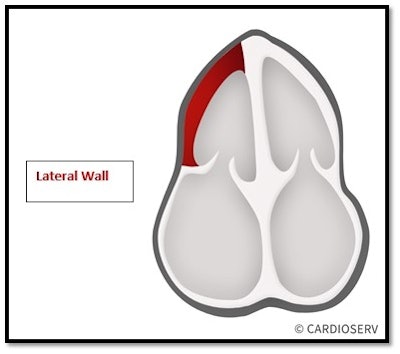
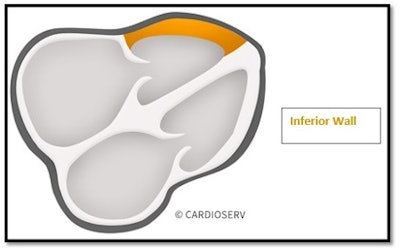
Imaging windows
Why is the RV so hard to image? The RV is the most anterior portion of the heart within the thorax, ending up in our near field of the ultrasound beam. This results in limited scanning windows and poor resolution.
In its updated guideline, the ASE explained that there are three different scanning views that can be obtained from the apical 4 (AP4) window to properly evaluate the RV and RA:
- Standard AP4 view
- RV-focused AP4 view
- RV-modified AP4 view
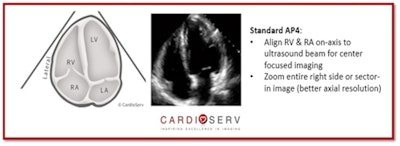


Please note that the purpose of the RV modified AP4 view is to qualitatively evaluate RV function; quantitative methods should not be measured in this view.
RV visualization problems
If you're having a hard time visualizing the RV in difficult or limited patients, there are a few techniques that can work. First, change the angle of the transducer. Try to move up or down a rib space.
Second, push IV saline, just as you would for a contrast study. This can facilitate visualization of the RV, but it only lasts for a few seconds.
Finally, you can also use intravenous contrast, just as you would for the left ventricular endocardium. It requires slower injection, however, to prevent attenuation artifacts.
Now that we've laid the foundation for the basics of correct right heart visualization, we will apply it in upcoming articles that will detail the correct methods for quantifying right heart size and function. Our next column will discuss the proper way of measuring the RV.
Andrea Fields is the clinical cardiac director at CardioServ. Andrea can be reached by email at [email protected] or via CardioServ's website. You can also connect with her on LinkedIn.
The comments and observations expressed herein do not necessarily reflect the opinions of AuntMinnie.com, nor should they be construed as an endorsement or admonishment of any particular vendor, analyst, industry consultant, or consulting group.



















